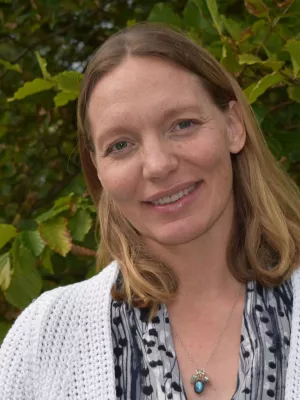
Marianne Hall
Forskningskoordinator

Carbon dioxide exchange of buds and developing shoots of boreal Norway spruce exposed to elevated or ambient CO2 concentration and temperature in whole-tree chambers
Författare
Summary, in English
Effects of ambient and elevated temperature
and atmospheric carbon dioxide concentration ([CO2]) on
CO2 assimilation rate and the structural and phenological
development of shoots during their first growing season
were studied in 45-year-old Norway spruce trees (Picea
abies (L.) Karst.) enclosed in whole-tree chambers.
Continuous measurements of net assimilation rate
(NAR) in individual buds and shoots were made from
early bud development to late August in two consecutive
years. The largest effect of elevated temperature (TE) was
manifest early in the season as an earlier start and
completion of shoot length development, and a 1–3-week
earlier shift from negative to positive NAR compared
with the ambient temperature (TA) treatments. The
largest effect of elevated [CO2] (CE) was found later in
the season, with a 30% increase in maximum NAR
compared with trees in the ambient [CO2] treatments
(CA), and shoots assimilating their own mass in terms of
carbon earlier in the CE treatments than in the CA
treatments. Once the net carbon assimilation compensation
point (NACP) had been reached, TE had little or no
effect on the development of NAR performance, whereas
CE had little effect before the NACP. No interactive
effects of TE and CE on NAR were found. We conclude that in a climate predicted for northern Sweden in 2100, current-year shoots of P. abies will assimilate their own mass in terms of carbon 20–30 days earlier compared with the current climate, and thereby significantly contribute
to canopy assimilation during their first year.
and atmospheric carbon dioxide concentration ([CO2]) on
CO2 assimilation rate and the structural and phenological
development of shoots during their first growing season
were studied in 45-year-old Norway spruce trees (Picea
abies (L.) Karst.) enclosed in whole-tree chambers.
Continuous measurements of net assimilation rate
(NAR) in individual buds and shoots were made from
early bud development to late August in two consecutive
years. The largest effect of elevated temperature (TE) was
manifest early in the season as an earlier start and
completion of shoot length development, and a 1–3-week
earlier shift from negative to positive NAR compared
with the ambient temperature (TA) treatments. The
largest effect of elevated [CO2] (CE) was found later in
the season, with a 30% increase in maximum NAR
compared with trees in the ambient [CO2] treatments
(CA), and shoots assimilating their own mass in terms of
carbon earlier in the CE treatments than in the CA
treatments. Once the net carbon assimilation compensation
point (NACP) had been reached, TE had little or no
effect on the development of NAR performance, whereas
CE had little effect before the NACP. No interactive
effects of TE and CE on NAR were found. We conclude that in a climate predicted for northern Sweden in 2100, current-year shoots of P. abies will assimilate their own mass in terms of carbon 20–30 days earlier compared with the current climate, and thereby significantly contribute
to canopy assimilation during their first year.
Publiceringsår
2009
Språk
Engelska
Sidor
467-481
Publikation/Tidskrift/Serie
Tree Physiology
Volym
29
Issue
4
Dokumenttyp
Artikel i tidskrift
Förlag
Oxford University Press
Ämne
- Earth and Related Environmental Sciences
Nyckelord
- climate change
- NAR
- net CO2 assimilation rate
- phenology
- photosynthesis
- Picea abies
- shoot development
Status
Published
ISBN/ISSN/Övrigt
- ISSN: 1758-4469